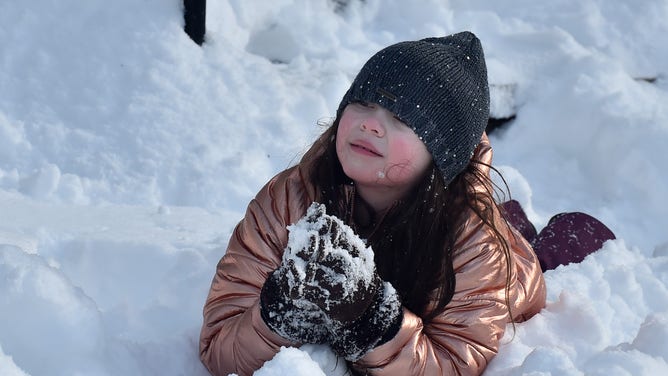Debunking Mom Myths: Will I really get the flu if I don’t wear a hat?
Is weather really responsible for the cold and flu?
A girl wearing a snowsuit, hat and gloves lies in the snow in Wilkes-Barre, PA.
(Aimee Dilger/SOPA Images/LightRocket via Getty Images) / Getty Images)
Yes, we’ve all been told by parents, teachers, grandparents, "Don’t go out with a wet head, you’ll catch pneumonia," and "Wear a hat, or you’ll come down with a cold." But, what really happens?
We are not the only ones who have questioned the sage advice.
Let’s start with the flu. Does cold weather give you the flu? The short answer is no. The flu, the influenza virus, becomes airborne in water droplets when someone sneezes or coughs. We all know after 2020 to stay six feet away from someone with the flu. The CDC says that the influenza virus can live on hands and surfaces that we touch and infect us when we touch a mucus membrane like our eyes, mouth, or nose. Point for no hat — you can’t catch flu through the top of your head.
So why do we link the flu with weather and seasons? Seasonal flu shot clinics are popping up around every corner. An article by a Harvard Ph.D. student even suggested that the word influenza translates in Italian to influenza di freddo, which means "influence of the cold." There must be something linking cold weather and illness.
The Harvard student looked at an experiment from a researcher who decided to test the "cold from cold" theory. He had groups of guinea pigs (which can be infected by influenza) in separate cages with the same airflow.
- If no guinea pig had the flu virus initially, none would have the flu at the end of the experiment at which the rodents were kept at 41 °F, 68 °F and 86 °F—point for no hat.
- He then infected guinea pigs in cage one only. Surprise, cage two guinea pigs caught the flu. He did this at different temperatures and relative humidity. At 41° and 35% relative humidity, the transmission was 100% -- everyone was sick At 41° and 80% relative humidity, the transmission was only 50% At 68° and 35% relative humidity, the transmission was still 100% At 68° and 80% relative humidity, the transmission was 25% -- only one guinea pig got sick At 86° degrees under low and higher humidity levels, the transmission rate was 0% -- no one was sick
- At 41° and 35% relative humidity, the transmission was 100% -- everyone was sick
- At 41° and 80% relative humidity, the transmission was only 50%
- At 68° and 35% relative humidity, the transmission was still 100%
- At 68° and 80% relative humidity, the transmission was 25% -- only one guinea pig got sick
- At 86° degrees under low and higher humidity levels, the transmission rate was 0% -- no one was sick
The National Institutes of Health explains that scientists took this further and paired weather data from 78 sites worldwide (between 1° and 60° latitude) with historical influenza activity rates from 1975 and 2008. With 75% to 87% accuracy, they found that the flu was most common one month after a month with the lowest specific humidity (ratio of water vapor to air), which coincided with the lowest temperatures. More specifically, the NIH said, "In places where monthly specific humidity dropped below about 11 to 12 grams of water per kilogram of air and temperatures sank below 18º to 21ºC for at least a month, flu activity peaked in winter." Again, point for no hat.
However, in the tropics, scientists found the highest flu rates in the most humid and rainy months of the year, getting more than six inches per month of precipitation. Flu is also tougher to transmit in the humid tropics because the water droplet around the virus is smaller and lighter, making it more likely to travel further and longer on air currents and stay airborne longer, says the NIH. No points awarded.
Mom did score a few points with some corollary advice:
- Take your vitamins -- Shorter days mean less sunshine and lower vitamin D levels. Low vitamin D levels are associated with increased autoimmunity and increased susceptibility to infection.
- Don’t touch that. You don’t know where it’s been -- People spend more time indoors in the cold, allowing those near spread viruses.
- Use a humidifier -- The CDC says that moisture actually helps keep our mucous membranes healthier and producing mucus, the protective barrier.
- Bundle up. You’ll catch your death of a cold -- Temperatures below 98.6 degrees in the nose inhibited immune responses in the mucus membrane of mice allowing the virus to replicate faster and more efficiently claimed in the Proceedings of the National Academy of Sciences.
That leaves four points for mom and the hat and three for no hat — she’s right again.

